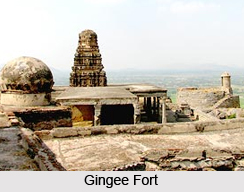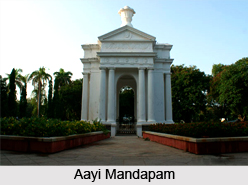 The monuments of Puducherry mirror a strong French influence in the designs of their constructions. This region is the capital of the Union Territory of Pondicherry, which is an amalgamation of all the former French settlements which were handed over to the Indian government in November 1854. The other territories - Mahe, Karaikal and Yanam - are administered from here.
The monuments of Puducherry mirror a strong French influence in the designs of their constructions. This region is the capital of the Union Territory of Pondicherry, which is an amalgamation of all the former French settlements which were handed over to the Indian government in November 1854. The other territories - Mahe, Karaikal and Yanam - are administered from here.
The history of Puducherry is a long process of conquests and sieges, full of endless disturbances and warfare. In 1672 Puducherry was bought by the French from the King of Bijapur. Initially, the old town was established by Francois Martin in 1674 as a trading settlement. In 1693 it fell to the Dutch, only to be restored four years later by the Treaty of Ryswick. After that it changed hands between the English and French no less than nine times. Under Dupleix from 1741 to 1754 it regained its former pre-eminence, but in 1761, during the Seven Years War, the British captured the town and razed its buildings. After repeated exchanges, the town was restored to the French in 1817. In 1940 it declared for the Free French.
Due to a more or less consistent French stronghold, most of the architecture here is accordingly constructed and named.
Historical Monuments in Puducherry
The War Memorial is one of the most prominent landmarks of Puducherry.It is located in Goubert Avenue( Beach Road in local parlance).The memorial is basically a tribute that has been erected to commemorate the French fall in WWI. It is an elegant tribute to the uniform. The memorial is very beautifully illuminated every year during a solemn ceremony held on the fourteenth of July, Bastille Day.
 A memorial statue of Dupleix is situated at the Goubert Avenue. He was the Governor of Puducherry between 1742 and 1754, and his life is greatly associated with the people of Puducherry. He had tried his best to prevent the British from establishing their supremacy in the Indian Territory.
A memorial statue of Dupleix is situated at the Goubert Avenue. He was the Governor of Puducherry between 1742 and 1754, and his life is greatly associated with the people of Puducherry. He had tried his best to prevent the British from establishing their supremacy in the Indian Territory.
There is a statue of Mahatma Gandhi, which stands on the beach front. All of 13 feet tall, it is surrounded by carved monolithic pillars built by the famous sculptor Roy Choudhary from Madras School of Art and Crafts.
The Palais Du Gouvernement is a brilliant example of town planning in Puducherry. It comprises the 18th century Palais Du Gouvernement and the old tribunals along with a neat three-sided line-up of other handsome buildings. The Palais Du Gouvernement, a fine example of French colonial architecture, is now the Raj Nivas, whereas the tribunals house the legislative assembly. At the centre of this is the Water Monument surrounded by a well tended garden. It has been sculpted to commemorate the introduction of good drinking water for the population. The story has been laid out in Latin and Tamil inscriptions. There are some beautifully carved monolithic pillars which decorate the place. These have been brought from the Gingee Fort after it was captured in 1751.
The Pondicherry Museum occupies the former Government Library and has extensive collections on French India and of sculptures, bronzes, arms, art and handicrafts. On the ground floor there is a major attraction in the form of three curious transport mechanisms-a palanquin, a coach and a pousse-pousse which required two attendants to be drawn-one to steer and one to push. There is a bronze gallery which has a display of the images of various Gods and Goddesses as well as a huge collection of temple lamps which were used by different dynasties over the centuries. There are also pre-Christian relics to be found here such as pieces from the Tsung Periods in China, remnants` of Greek and Roman amphora jars and beads made from glass and precious stones which were dug out from Arikamedu site, just south of Puducherry.
The House of Ananda Rangapillai, Dupleix`s prot‚g‚, is a fascinating mixture of Eastern and French colonial styles. He was an 18th century diarist and his compilation of diaries serve as a storehouse of information and knowledge on India under the French in the 18th century. His mansion was constructed in 1837 and it is one of the oldest surviving buildings on the west side- then known as "natives` quarters". The House has now been converted into a museum.
A 19th century lighthouse is yet another attraction of Puducherry.It stands on the edge of the sea, near the Place du Gouvernement and was lighted for the first time on 1 July, 1836.The beacon was kept burning on the Red Hills for the aid of early seafarers who came to Puducherry. The light was kept on a masonry tower which was 29 m above sea level and visible as far as a distance of 29 kms into the sea. In 1931, the fixed light was replaced by a revolving lantern. It fell into disuse with the commissioning of the new light house in 1979.
One of the most beautiful places in town is the Government Park in the heart of Puducherry. Right in the centre of this park is the Aayi Mandapam. It has been built in the Graeco Roman style of architecture during the reign of Napoleon III, Emperor of France.
 The Mandapam bears the name of Aayi, a sixteenth century courtesan. Story goes that when her candle-lit house was mistaken for a holy place by a passing King, she razed down her hose and replaced it with a reservoir to appease the King. Napoleon was greatly charmed by the story and ordered a monument to be built for Aayi.
The Mandapam bears the name of Aayi, a sixteenth century courtesan. Story goes that when her candle-lit house was mistaken for a holy place by a passing King, she razed down her hose and replaced it with a reservoir to appease the King. Napoleon was greatly charmed by the story and ordered a monument to be built for Aayi.
Religious Monuments in Puducherry
A number of imposing churches are found in Puducherry, built by the French missionaries and settlers in the 17th and 18th centuries.
The Eglise de Sacre Coeur de Jesus or the Church of the Sacred Heart of Jesus is situated on the South Boulevard. It has been built in the 19th century Gothic style with a large crocketed central gable flanked by two towers in white stucco with red dressings. It contains some beautiful rare stained glass panels which depict events from the life of Jesus Christ.
The Eglise de Notre Dame de la Conception Immaculee was started in 1691 and completed in 1765. It is located in Cathedral Street.
The Eglise de Notre Dame des Anges, in Rue Dumas, was designed by Louis Guerre and built in 1855. It is notable for the masonry which uses a mixture of the finest of limestone and the white of the egg. It has a texture identical to that of white marble. In the Church is found a rare oil painting of Our Lady of Assumption presented by Napoleon III.
The Eglise de Notre Dame de Lourdes is situated at Villcnour, outside of town. It was modeled along the lines of the Basilica at Lourdes. It was built in 1876 and a statue of Our Lady was presented to the Church by the French Government a year later. The Church is a unique Catholic shrine because it is one of the few which has its own tank. An annual festival is held here in the month of June.
The Chapel of Our Sisters of Cluny is a small 17th-century shrine.
At Ariyan-kuppam, about 4 km (2`/2 miles) outside Pondicherry, is an 18th-century chapel, reputed to have been a favorite resort of Dupleix and his wife.
Puducherry thus has a rich cultural landscape which offers a peak into life as it was in colonial India under French rule.



















